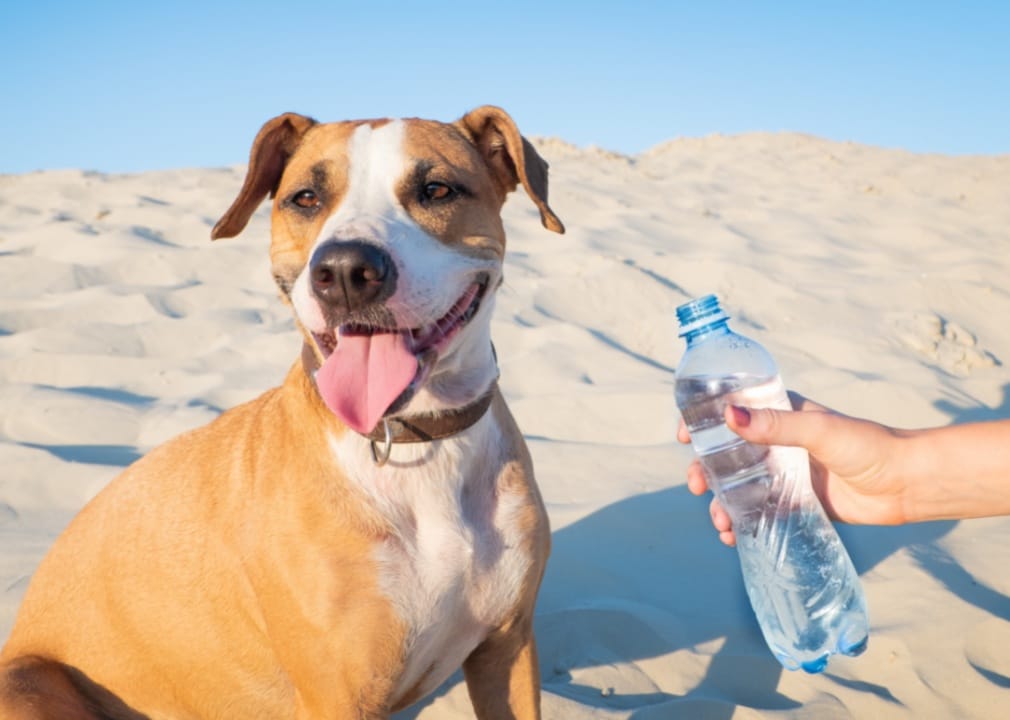While sunny months may seem like an ideal time for dog owners to be out and about with their pets, the hot weather can be harmful to dogs so you need to think about how to keep them cool. ManyPets analyzed research and reports from veterinary schools and other pet experts to compile a list of ways to protect your dog from hot weather.
The health issues dogs experience during the summer season underscore the dangers of extreme weather — pet parents need to be proactive about their dogs’ safety.
According to American Veterinary Medical Association research, hundreds of dogs die yearly from heat exhaustion after being left in hot cars. A U.K. study discovered that dogs are just as likely to die from exercise-induced heat stroke as they are from being left in hot cars.

Keep your dog cool in hot weather
Heat stroke in dogs is a potentially deadly condition. With the rise in global temperatures, it might become more common.
This condition in dogs usually occurs when body temperatures rise beyond 106 degrees Fahrenheit, even without previous signs of illness. However, a U.S. military study shows that working canines’ temperatures may routinely approach 108 degrees Fahrenheit without causing harm.
While military dogs can withstand extreme temperatures, other dogs, like flat-faced breeds and older dogs, are at greater risk of heat stroke.
Also, big, fluffy dog breeds tend to overheat sooner than dogs with thinner coats.
Heat exhaustion is also a concern
As severe and extreme as heat stroke is, it is not the only dog health issue that accompanies hot weather. Heat cramps and heat exhaustion are less severe conditions that may arise.
Common symptoms are excessive panting or difficulty breathing, fever, rapid pulse and muscle tremors. However, your dogs may suffer from heat exhaustion and you may not know it — in other words, the symptoms aren’t obvious.
For example, recently we took out dogs Oscar and Sadie with us on a day of outdoor shopping. Yes, it was hot. However, we gave them water regularly and took breaks in the shade.
Two days later both dogs developed diarrhea. At first we thought maybe they ate something bad. Then we did some Google searching and found out that diarrhea during the summer could be a sign of dehydration and heat exhaustion in dogs. And here we thought we’d done a good job of keeping our dogs cool.
Continue reading for seven ways to help keep your dog cool and protected during the hottest months of the year.
Take them swimming
Nothing beats a cold dip on a bright and sunny day. Dogs love splashing in the water to cool down, and swimming is a terrific alternative to walking in the summer heat. Swimming is an excellent aerobic exercise that tones and strengthens a dog’s muscles and cools the body down.
While swimming is fun for dogs, owners must take certain precautions to keep their pets safe.
Not all dogs know how to swim
It’s a common belief that all dogs can swim, but this is a myth. If a dog does not enjoy swimming, do not force them to do it, and never toss a dog into the water.
Dogs can and do drown. Lakes and rivers can also be attractive swimming spots, as long as owners take care to observe the current at the river.
Even better: get a life vest for your dog to help keep them safe in the water.
Watch out for unsafe water
Dog owners also need to steer clear of areas with cyanobacteria, also known as blue-green algae, which can cause severe neurological or liver damage. After swimming—whether in a pool, river, lake, or ocean—pet owners should always rinse off their dog with clean water to remove any chemicals or debris.
Finally, watch the flags at the beach for other dangers in the water. Red flags usually mean unsafe conditions because of strong waves or currents. However, they can also be a warning against unsafe swimming because of bacteria. So, if you want to take your dog swimming after rain storms, your local watering hole may have a high e. coli level from runoff and you should hold off — especially if you see red flags.
Cover their paws
Sunny days often mean more play time for dogs, but owners must be mindful of the hazard to paws when the temperature rises. Common paving materials can reach 150 degrees Fahrenheit in the height of summer, according to the Environmental Protection Agency.
Asphalt surfaces, for example, absorb a great deal of the sun’s heat and even contribute to the surrounding air temperature. That’s why whenever I take Oscar and Sadie out in the summer, I’ll put my hand down on the pavement before stepping off the curb. If it’s too hot for my hands, it’s too hot for their paws.
When owners walk their dogs on hot surfaces for too long, they risk getting pad burns. Burns can cause blistering, tissue loss, and severe pain.
Keep them groomed
In hot weather, regular grooming helps keep dogs cool. Although dogs do not sweat through their skin, grooming helps brush off dead or extra hair. This leaves your dog with a thinner coat that is better for remaining cool. In the process, dog parents also get the chance to spot infections, allergies, fleas and ticks.
The best dog brush for getting the undercoat is the Furminator.
Don’t shave your dog down
A common misconception is that shaving a dog’s hair helps keep them cool. It might sound surprising, but shaving has little effect on cooling them down.
Rather, giving your dog a crew cut, as it were, exposes a dog and its sensitive skin to health risks. When the temperature rises, a dog will naturally undergo a coat change (molting), meaning its thicker coat thins out.
Therefore, instead of shaving, dog groomers advise trimming the hair. Shortening the hair reduces the heat trapped against the skin and helps the dog stay cool.
Give them frozen treats
Cold treats can keep dogs happy and cool them down when they feel hot and listless. Dog owners can make tasty frozen treats with peanut butter, tuna, salmon or other dog-friendly food.
As with any new treats, start with a modest quantity to ensure your dog’s digestive system can manage the treat without leading to vomiting or diarrhea. Dog owners must also be mindful of the added calories to prevent their dogs from becoming obese or overweight.
The frozen treats must be a suitable size for your dog. In other words, don’t feed a little dog a chunky frozen treat. That can be a choking hazard.
In these cases, smaller treats or even ice flakes are preferable. These are also beneficial for dogs—regardless of their size—who have a tendency to wolf down food.
Limit walks to early mornings and evenings
Rain or sun, summer or winter, regular walks are necessary to help dogs exercise and stay healthy. Experts agree that taking your dog for a walk in temperatures up to 68 degrees Fahrenheit is generally safe.
But anything above 77 degrees Fahrenheit is regarded as risky. This is especially true for large-breed or flat-faced dogs, dogs that are very young or very old, pregnant dogs, and dogs that suffer from obesity or other underlying health problems. It’s even possible for dogs to suffer heat stroke at temperatures as low as 70 degrees Fahrenheit.
The best time of the day to walk your dog is in the morning or evening when it’s cooler. Taking a dog on a walk at these times reduces the risk of heat stroke. Walking your dog in the morning or evening also reduces the risk of dogs burning their paws on pavement.
Just keep in mind: While certain dogs are at higher risk, all dogs are vulnerable to heat-related health conditions, including heat stroke.
Wrap them in a cool towel
To help dogs cool down, especially during the hot weather, owners can soak a towel in cool water—not ice cold water—and place it around their dog. The towel should not be left on the dog for too long because it can become hot and raise the dog’s temperature instead of lowering it.
Protect their skin from the sun
It’s no secret dogs love being outside, but dog owners must safeguard their furry friends from harmful UV rays that can cause skin conditions. This is why protecting your pooch’s skin is essential.
Sunscreen keeps pets safe from harmful rays. However, applying the incorrect type of sunscreen might also cause issues.
Dog owners must only use sunscreen designed exclusively for dogs. These products do not include zinc oxide or para-aminobenzoic acid, compounds that are hazardous to dogs if consumed.
A waterproof, odorless dog sunscreen with a sun protection factor of 30 is also recommended. For dog owners unable to find a suitable sunscreen, UV-blocking sun shirts are a good alternative.
Final thoughts on keeping dogs cool during hot weather
Now we know that during hot, summer days, it’s probably best to leave our dogs home in the air conditioning rather than take them out shopping with us — even with plenty of water and resting in the shade.
This story originally appeared on ManyPets and was produced and distributed in partnership with Stacker Studio. It has been re-published pursuant to a CC BY-NC 4.0 License.


